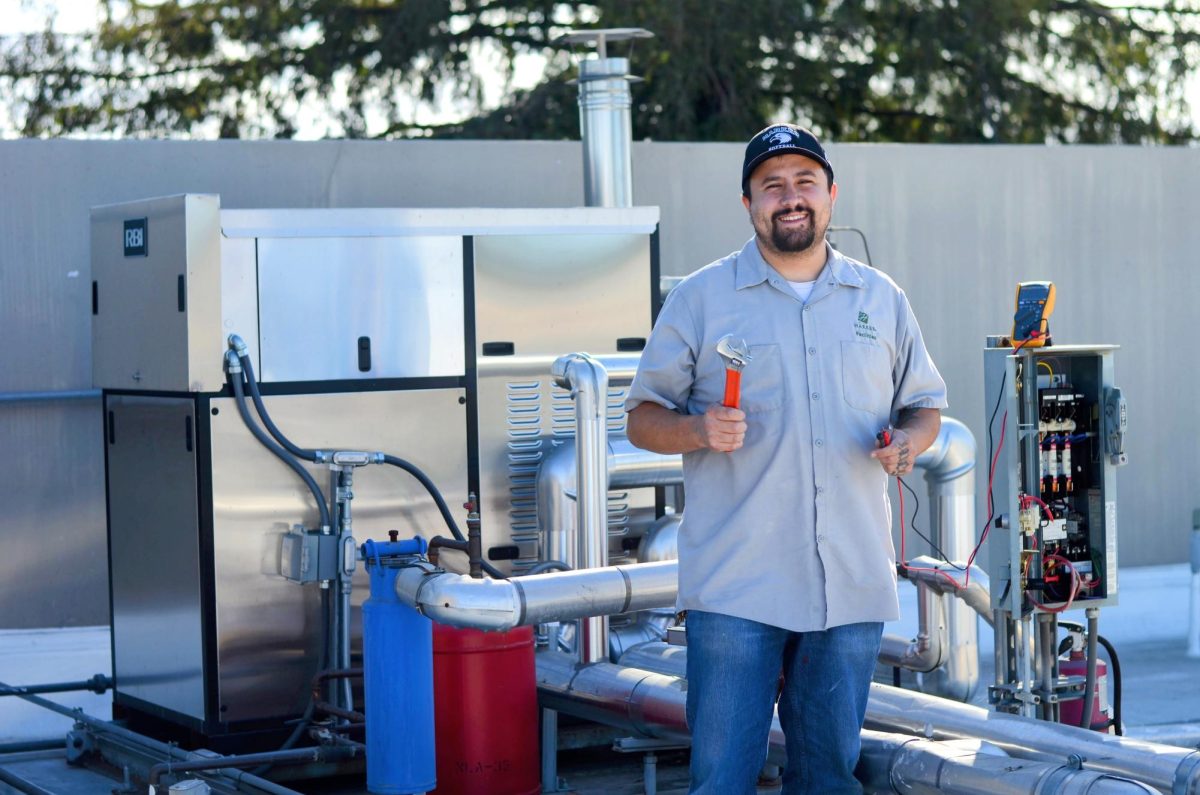Early winter brings a chill to campus, as students dart briskly through rainy days and jackets start to layer onto their backs. But students find warm refuge in their classroom buildings, thanks to a campus-wide network of heating and cooling systems.
Facilities manager J.R. Del Alto remembers when he started working at the upper school in 1982, the campus used furnace heaters that doubled as fans for cooling in the summer. Now, the newer buildings have HVAC systems that can efficiently control heating, cooling and humidity, while the older buildings use standard compressor ACs.
Nichols Hall, the athletic center and the Rothschild Performing Arts Center, the three newest buildings, use newer boiler systems that radiate heat through steam, a method that is more energy-efficient and creates more comfortable heating than traditional furnaces. These buildings also have more precise temperature control.
“The older buildings are controlled by a thermostat and the stats are set within hard parameters,” Del Alto said. “The air temperature won’t drop below 68 degrees and it won’t go above 74. In newer buildings, teachers are able to control their rooms to a two-degree differential.”
Differences in thermostat control mean that while older buildings like Dobbins and Main Hall maintain relatively uniform temperature, teachers personally adjust the temperatures of their classrooms in buildings like the RPAC and Nichols.
“It all depends on the teacher,” Del Alto said. “Some like it a little warm, some like it a little cooler because they don’t want the students to fall asleep. That’s the way those systems are set up.”
Despite the more advanced and efficient tech installed in the newer buildings, environmental efforts sometimes lead to decreased comfort for people on campus. Nichols was originally built with a LEED Gold-certified evaporative cooling system in 2009 to stay in line with Harker’s sustainability goals; however, the cooler caused excessive humidity in the building.
Chemistry teacher and Sustainability Coordinator Andrew Irvine recalls that complaints about the humidity in Nichols led to the evaporative cooling system’s eventual replacement with the same HVAC as RPAC.

“The evaporation of the water would result in the cooling of the air, and it was really energy efficient, but this building would be more humid than Costa Rica on a summer day,” Irvine said. “It was just not a good system for people trying to do controlled chemical research. So we eventually got it switched to the more traditional HVAC system that was in the RPAC, which is actually even more efficient.”
Sophomore Nyssa Kansal prefers the moderate temperatures in Nichols and would rather have consistent conditions in all her classrooms.
“I like Nichols’ temperature. I feel like it’s the perfect temperature and it’s never too hot or too cold there,” Nyssa said. “When I feel the cold in my bones, I feel tired and then I go to sleep. When it’s really hot, I can’t focus.”
The facilities crew is planning the initiative to replace the AC systems in Main and the Auxiliary Gym and revamp Dobbins with a more energy-efficient one. Junior Yena Yu hopes that the school will model the new Dobbins AC after RPAC’s HVAC or a more energy-efficient version of Shah in order to replicate their warmth.
“It’s ok to have one or two buildings that are abnormally cold, but I don’t think all the buildings should be like that,” Yena said. “I fall into this state of mental numbness when it’s so cold and clammy. RPAC is warm and it definitely has the best system. It’s so effective. Whatever they do in the RPAC, if they copy it in Dobbins, then I am totally for it.”
“I do know that we’re making progress,” Irvine said. “It’s going to be more expensive, but the return of investment over the long haul is going to be better than other options. My ethic is that it’ll save money, in addition to being sustainable.”




![LALC Vice President of External Affairs Raeanne Li (11) explains the International Phonetic Alphabet to attendees. "We decided to have more fun topics this year instead of just talking about the same things every year so our older members can also [enjoy],” Raeanne said.](https://harkeraquila.com/wp-content/uploads/2025/10/DSC_4627-1200x795.jpg)


















![“[Building nerf blasters] became this outlet of creativity for me that hasn't been matched by anything else. The process [of] making a build complete to your desire is such a painstakingly difficult process, but I've had to learn from [the skills needed from] soldering to proper painting. There's so many different options for everything, if you think about it, it exists. The best part is [that] if it doesn't exist, you can build it yourself," Ishaan Parate said.](https://harkeraquila.com/wp-content/uploads/2022/08/DSC_8149-900x604.jpg)




![“When I came into high school, I was ready to be a follower. But DECA was a game changer for me. It helped me overcome my fear of public speaking, and it's played such a major role in who I've become today. To be able to successfully lead a chapter of 150 students, an officer team and be one of the upperclassmen I once really admired is something I'm [really] proud of,” Anvitha Tummala ('21) said.](https://harkeraquila.com/wp-content/uploads/2021/07/Screen-Shot-2021-07-25-at-9.50.05-AM-900x594.png)







![“I think getting up in the morning and having a sense of purpose [is exciting]. I think without a certain amount of drive, life is kind of obsolete and mundane, and I think having that every single day is what makes each day unique and kind of makes life exciting,” Neymika Jain (12) said.](https://harkeraquila.com/wp-content/uploads/2017/06/Screen-Shot-2017-06-03-at-4.54.16-PM.png)








![“My slogan is ‘slow feet, don’t eat, and I’m hungry.’ You need to run fast to get where you are–you aren't going to get those championships if you aren't fast,” Angel Cervantes (12) said. “I want to do well in school on my tests and in track and win championships for my team. I live by that, [and] I can do that anywhere: in the classroom or on the field.”](https://harkeraquila.com/wp-content/uploads/2018/06/DSC5146-900x601.jpg)
![“[Volleyball has] taught me how to fall correctly, and another thing it taught is that you don’t have to be the best at something to be good at it. If you just hit the ball in a smart way, then it still scores points and you’re good at it. You could be a background player and still make a much bigger impact on the team than you would think,” Anya Gert (’20) said.](https://harkeraquila.com/wp-content/uploads/2020/06/AnnaGert_JinTuan_HoHPhotoEdited-600x900.jpeg)

![“I'm not nearly there yet, but [my confidence has] definitely been getting better since I was pretty shy and timid coming into Harker my freshman year. I know that there's a lot of people that are really confident in what they do, and I really admire them. Everyone's so driven and that has really pushed me to kind of try to find my own place in high school and be more confident,” Alyssa Huang (’20) said.](https://harkeraquila.com/wp-content/uploads/2020/06/AlyssaHuang_EmilyChen_HoHPhoto-900x749.jpeg)






